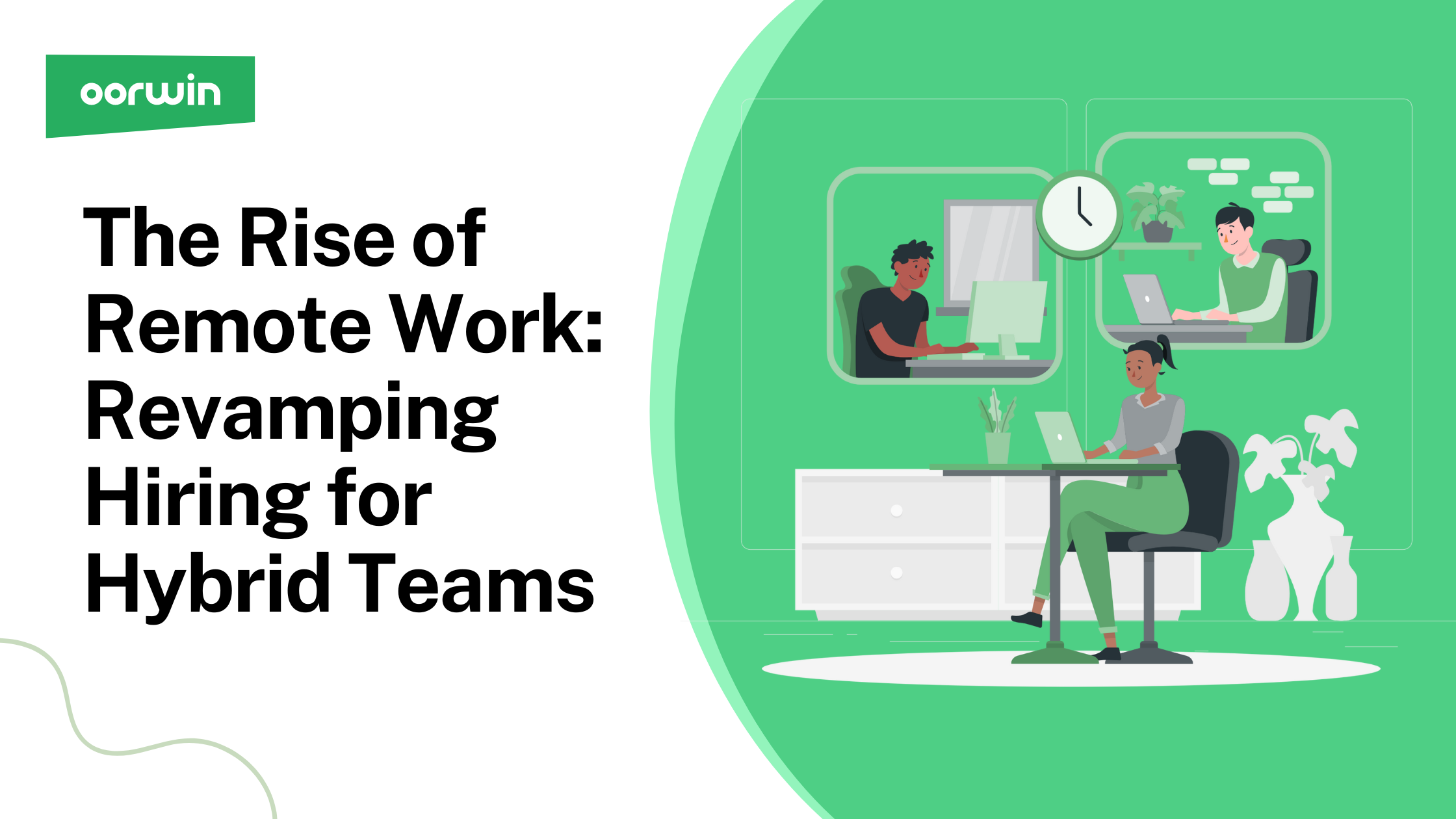The Rise of Remote Work: Revamping Hiring for Hybrid Teams
Oorwin
4min read / 26 Jul 2023

Related Articles
What is Remote Work?
Remote work is where employees perform tasks outside the traditional office environment. It allows individuals to work from home, co-working spaces, or other locations, using technology to stay connected with colleagues and the organization. Remote work has recently gained popularity, transforming the job market dynamics and recruitment strategies.
What is a Remote Workforce
A remote workforce refers to a group of employees who perform their job duties and tasks from locations outside of a traditional office environment. These employees work remotely, often from their homes, co-working spaces, or other remote areas. They stay connected with their colleagues and the organization through technology, such as the Internet and communication tools. The remote workforce model offers flexibility and allows employees to work from anywhere, providing benefits such as improved work-life balance and access to a broader talent pool for employers.
Reasons Behind the Surge in Remote Work
Remote work has experienced a significant surge due to several factors:
- Advancements in Technology: The widespread availability of high-speed internet and collaboration tools has made remote work more feasible and efficient.
- Work-Life Balance: Employees seek better work-life balance, and remote work provides the flexibility to manage personal and professional responsibilities.
- Cost Savings: Employers benefit from reduced overhead costs, such as office space and utilities, by embracing remote work.
- Global Talent Pool: Remote work allows companies to tap into a diverse global talent pool, overcoming geographical limitations.
Advantages and Challenges of Remote Work
Remote work offers numerous advantages and challenges for both employees and employers:
Advantages:
- Improved Work-Life Balance: Employees can better manage personal and family commitments while meeting work requirements.
- Increased Productivity: Some individuals find remote work environments more conducive to focus and productivity.
- Cost Savings: Employers save on office-related expenses and may attract candidates willing to work for a lower salary in exchange for flexibility.
Challenges:
- Communication and Collaboration: Remote work can sometimes lead to communication gaps and challenges in team collaboration.
- Work-Life Boundaries: Employees may struggle to separate work and personal life, leading to potential burnout.
- Technology and Connectivity: Reliance on technology means disruptions in internet connectivity or technical issues can impact productivity.
Impact of Remote Work on Recruitment Strategies
The rise of remote work has necessitated changes in recruitment strategies:
Changes in Job Market Dynamics
The job market has become more competitive as remote work allows companies to hire candidates from anywhere. This opens up opportunities for job seekers while requiring businesses to stand out in attracting top talent.
Adjustments in Job Roles and Descriptions
Job roles and descriptions must be redefined to include remote-specific responsibilities and emphasize essential skills like self-motivation and time management.
Modifications in Interview and Selection Processes
Virtual interviews have become standard in remote recruitment, requiring employers to assess candidates’ adaptability to remote work environments and strong communication skills.
Adapting Traditional Recruitment for a Hybrid Workforce
As companies transition to hybrid work models, they must adapt their recruitment practices accordingly:
Emphasizing Soft Skills and Remote Readiness
Evaluating candidates’ soft skills, such as communication, adaptability, and problem-solving, becomes crucial to ensure they thrive in hybrid work settings.
Adopting Virtual Recruitment Tools
Virtual recruitment tools, like video interviewing platforms and online candidate assessment tools, streamline the hiring process and provide valuable insights into candidates’ remote work capabilities.
Building Remote-Friendly Company Culture
Fostering a remote-friendly company culture ensures employees feel connected, engaged, and supported, regardless of their work location.
Diversity and Inclusion in the Recruitment Process
Amid the evolving landscape of remote and hybrid work, the significance of diversity and inclusion in the recruitment process cannot be overstated. Employers must actively prioritize diversity to harness the full potential of a hybrid workforce. Inclusive recruitment practices ensure talent is sourced from various backgrounds, experiences, and perspectives, enriching the collaborative environment.
Challenges of Hiring for a Hybrid Workforce
Hiring for a hybrid workforce, where employees split their time between working remotely and in the office, presents several unique challenges for organizations. Balancing the needs of both remote and in-office workers while maintaining productivity, communication, and company culture can be complex. Here are some challenges you might encounter:
Talent Pool Access: When hiring for a hybrid workforce, consider candidates from a wider geographical area to have a broader scope of talent pool. This can be advantageous in accessing diverse talent but might also complicate matters such as coordinating interviews across different time zones.
Equitable Treatment: Ensuring equitable treatment of remote and in-office workers is essential. There’s a risk that remote workers may feel excluded from opportunities, important meetings, or career growth.
Communication and Collaboration: Effective communication becomes more challenging in a hybrid environment. There’s a need to ensure that remote employees have access to the same information and opportunities for collaboration as their in-office counterparts.
Company Culture: Building and maintaining a strong company culture can be difficult when employees work remotely part of the time. Creating a sense of belonging, shared values, and team spirit might require extra effort in a hybrid work setting.
Performance Evaluation: Assessing the performance of remote workers can be challenging due to the lack of physical presence and direct supervision. Finding fair and accurate ways to measure and evaluate performance is essential.
Managerial Skills: Managers must adapt their leadership styles to accommodate in-person and remote team members. Balancing communication methods, fostering teamwork, and addressing individual needs become more nuanced.
Onboarding and Training: Onboarding new employees and providing ongoing training can be challenging in a hybrid environment. Ensuring that remote hires have the same level of access to learning opportunities as in-office employees is vital.
Role of Technology in Hybrid Workforce
Technology is pivotal in enabling seamless communication, collaboration, and productivity between remote and in-office employees in a hybrid workforce.
Importance of Efficient Digital Infrastructure
Employers must invest in robust digital infrastructure to ensure smooth communication, data security, and collaboration for remote teams.
Use of AI and Machine Learning in Recruitment
AI-powered recruitment tools can help in candidate screening, matching, and predicting job fit, streamlining the selection process.
Leveraging Collaboration Tools for Remote Teams
Collaboration and project management tools enable remote teams to work efficiently, enhancing productivity and seamless communication.
The remote workforce has become an integral part of the modern job market, bringing advantages and challenges to employees and employers alike. As companies adapt their recruitment strategies for the hybrid workforce, prioritizing soft skills, adopting virtual tools, building a remote-friendly culture, and leveraging technology will be crucial for success. Embracing remote work’s potential while addressing its challenges will ensure a thriving and productive workforce in the digital era.
Leverage the best of both working conditions with Oorwin, a talent intelligence platform where recruiters can leverage 150+ integrations of virtual interview tools and communication tools. If it sounds too good to be true, the free demo is on us. Book now.
Frequently Asked Questions
What is a Hybrid Workforce?
A hybrid workforce is a work model that combines both remote and in-office employees. In this arrangement, some team members work from a physical office, while others work remotely, allowing for flexibility and collaboration through technology.
How has the rise of remote work affected recruitment strategies?
The rise of remote work has led to changes in recruitment strategies, focusing on assessing candidates’ remote readiness, communication skills, and adaptability to virtual environments. Virtual interviews, online assessments, and flexible job descriptions have become essential for recruitment.
What are some successful examples of recruitment strategies for a hybrid workforce?
Implement competency-based virtual interviews to evaluate candidates’ remote and soft work skills.
Offering flexible work arrangements, showcasing the company’s commitment to work-life balance.
Utilizing AI-driven tools for candidate screening to identify suitable remote candidates with specific skill sets efficiently.
Popular Articles..
Blog

5min read / 25-Jun-2025
Master Effective Interview Techniques with Oorwin: A Step-by-Step Recruiter’s Guide
Blog
Blog
Get the latest Oorwin releases, updates, success stories & industry news
 Back
Back
